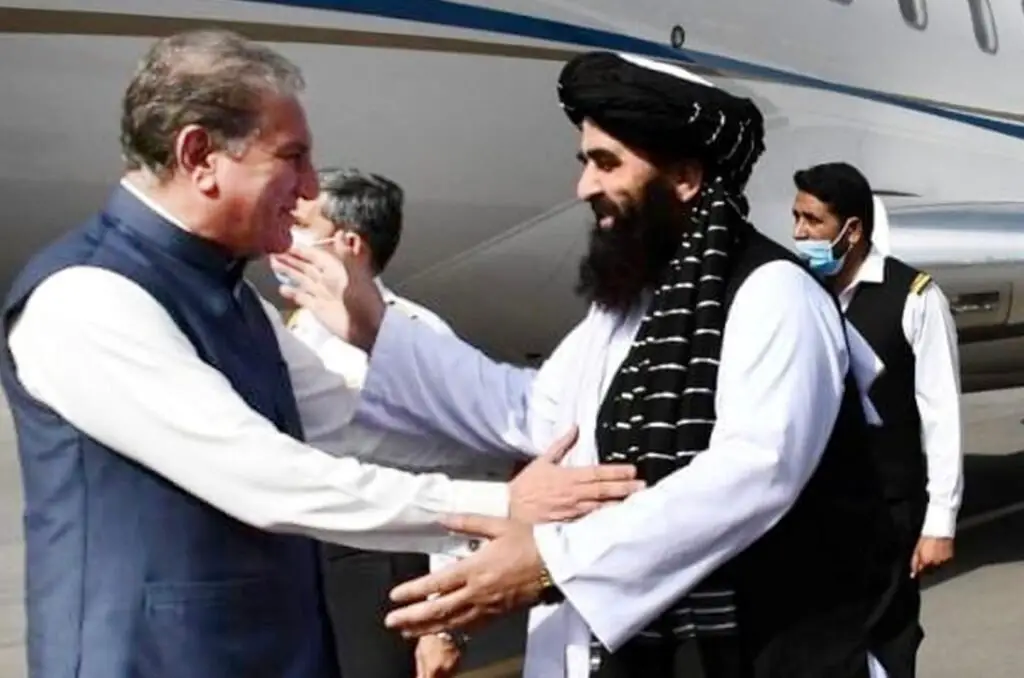When the Taliban seized power in Kabul in August 2021, Pakistan’s Interior Minister Sheikh Rasheed Ahmed held a triumphant press conference at the Torkham border crossing with Afghanistan.
He claimed that the Taliban’s rapid rise to power would create “a new bloc” and the region would assume great global importance. Imran Khan, then Pakistan’s prime minister, equated the Taliban’s return to power with Afghans “broken the shackles of slavery“.
For nearly 20 years, the Afghan Taliban fought a sophisticated and persistent insurgency that at times faced a U.S.-led coalition of more than 40 countries in Afghanistan. During this time, Taliban leaders and fighters found refuge in Pakistan in the border regions with Afghanistan. Taliban leaders also established presence and ties with major cities in Pakistan such as Quetta, Peshawar and later Karachi.
Many Taliban leaders and many fighters are graduates of Pakistani Islamic religious schools, including Darul Uloom Haqqania, where Mullah Muhammad Omar, the founder of the Taliban movement, reportedly studied. In Pakistan, the Taliban found an ecosystem that fostered organic relationships across the spectrum of Pakistani society, allowing the group to reorganize and initiate a deadly insurgency that began around 2003. Without Pakistan’s support and sanctuarya successful Taliban insurgency would have been highly unlikely.
This background explains the recent deterioration in bilateral relations with the Pakistani military leadership Airstrikes in Afghanistan this week – just the latest evidence of tensions between Islamabad and the Afghan Taliban?
Historical and current factors
Afghanistan has a complicated history with Pakistan. While Pakistan welcomed the Taliban in Kabul as a natural ally, the Taliban government is proving less cooperative than Pakistan had hoped, using nationalistic rhetoric to win the support of broader Afghan society. Taliban leaders are also seeking to transform themselves from a fighting group into a government, said to be an ongoing effort, and to build ties beyond a heavy reliance on Pakistan.
The Durand lineA colonial-era border that separated the regions and communities between Afghanistan and what is now Pakistan was not officially recognized by any Afghan state after the creation of Pakistan in 1947. The Durand Line is internationally recognized as the border between the two countries and Pakistan has almost completely fenced it off. But in Afghanistan, the Durand Line has become an emotional issue because it divides Pashtuns on both sides of the border.
The Taliban government did not support the Durand Line in the 1990s, and the current Taliban regime follows its predecessors. In Pakistan, this is seen as a nuisance and a challenge to Pakistan’s “strategic depth” doctrine in Afghanistan.
With the success of the Taliban in Afghanistan, the arena of armed rebellion appears to have shifted to Pakistan. There was a significant one Increase in militant attacks on Pakistani security and police forces since 2022 – particularly in the provinces of Khyber Pakhtunkhwa and Balochistan.
Most attacks are carried out by the Tehreek-e-Taliban Pakistan (TTP), the so-called Pakistani Taliban. The TTP and the Afghan Taliban maintained a symbiotic relationship for years, sharing refuge, tactics and resources, often in Waziristan and other Pakistani border regions with Afghanistan.
Pakistan treated the Afghan Taliban as “friends” after 2001, in part to weaken any sense of cross-border Pashtun nationalism and in the hope of exploiting its influence over the Taliban in developments in Afghanistan and in relations with the United States. In 2011, Michael Mullen, then US military chief, said that the Haqqani network – a key component of the Afghan Taliban – was a “true arm” of the Inter-Services Intelligence Agency (ISI), Pakistan’s powerful intelligence agency. Analysts predicted, as feared, that Pakistan’s support for the Taliban’s takeover in Afghanistan would lead to aPyrrhic victoryPakistani militant groups and other violent non-state actors felt emboldened, not weakened.
The meaning and effects of tension
It is unlikely that the Taliban would accept Pakistani demands to take action against TTP leaders in Afghanistan’s border areas with Pakistan. Crucially, such an approach would upset the Taliban’s balance with the TTP and create space for other, more extreme groups such as the Islamic State in Khorasan Province (ISKP). Taliban leaders are applying the same logic that Pakistan has used for nearly two decades, rejecting calls from the former Afghan government and the United States to curb Taliban activity in its territories. Like Pakistan then, the Taliban today argue that the TTP is an internal Pakistani affair and that Islamabad must resolve its problems at home.
The Pakistani army will most likely continue to bomb Afghan territory with impunity, drawing little international condemnation. Unfortunately, there is a growing international predominance. Countries like Israel carry out cross-border airstrikes, claiming they pose security threats. In addition, the Pakistan Army, as a long-time guardian of security in the country, is under enormous pressure to take concrete measures to combat militancy and protect the country’s infrastructure, including Chinese-invested economic projects in Balochistan. The attack on Afghan territory makes it possible to direct political messages to the Pakistani population at an “enemy” activated from outside. It also protects the state from compromising on growing domestic demands for political and socio-economic empowerment, particularly from Pakistan’s Pashtuns.
Meanwhile, the Taliban government in Afghanistan lacks the resources, an organized army and meaningful international partnerships to defend itself against Pakistan’s assertiveness. In March 2024, a senior Taliban military leader stated that the US remained in control of Afghan airspace, explaining the occasional appearance of US drones in Afghan skies.
Although Taliban leaders have promised “retaliation,” it is unclear how they can carry it out against a militarily strong neighbor who also happens to be their long-term strategic supporter. Pakistan also has other means of exerting influence against the Taliban: most of its trade with landlocked Afghanistan passes through Pakistan, and Pakistan has hosted millions of Afghan refugees for decades.
However, Pakistan’s military action within Afghanistan will fomenting anti-Pakistani sentiments among the Afghan population and further alienates the Pakistani Pashtuns. As the Afghan case shows, uprisings feed on social resentment, deprivation and disillusionment among young people.
Solutions require that leaders demonstrate the courage to address long-term grievances. A reactionary show of force may represent momentary gestures, but achieving peace is usually an art of wisdom and patience. Ironically, Pakistan and Afghanistan offer viable avenues for regional economic integration, connecting the Central Asia and South Asia regions. Unfortunately, the lack of political will and vision among leaders for a generation and the securitization of bilateral relations have affected the prosperity of more than 300 million people in both countries.




